
13 CURIOS FROM THE NEW CENTURY
page 2
christopher funderburg
Izo
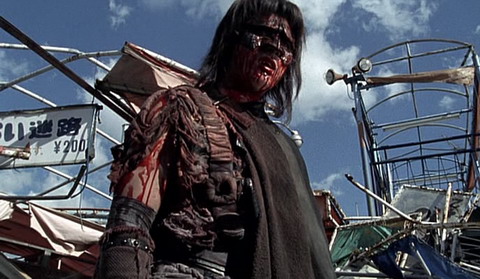
At this point, it probably won't impress anyone to read that the insanely prolific, utterly lunatic director Takashi Miike made truly crazy film. After all, Miike specializes in intensely harrowing, weird, shocking and out-of-their-fucking-mind provocations like Ichi the Killer, Visitor Q, The Happiness of the Katakuris and Gozu. There's a level on which it's more surprising to see him produce something like the good-natured, family-friendly The Great Yokai War or the genuinely sweet (maybe even inspiring) The Bird People of China. But naturally, most every cinephile is well aware of Miike's prodigious output (over 70 films in a career not even 2 decades in length) and not very surprised to hear about another eccentric project spewing out of the pipeline. It's easy to be jaded about the work of a guy who has built his reputation on extremes, shock-value and unpredictability: of course, Miike has made a movie about a button-down businessman hiding a violent past as a tattooed yakuza enforcer or a quiet period romance or a rousing superhero comedy.
Keeping that in mind, I will still submit that few films have so single-mindedly and effectively pursued a bizarre concept as Izo – this is a strange idea for a film, even beyond the outré standards well established by one cinema's most deranged practitioners of strangeness. What the makes the film particularly outstanding is its decisive unwillingness to deviate from its conceptual oddity: the form of the narrative is by its nature incoherent and the film's devotion this structure gives it an inchoate, almost formless, feel. But its repetitive, singled-minded construction gives it an unusual predictability and focus: this is one of the few films where an audience could easily not understand a thing that's going on but still know exactly what's going to happen next.
So what is it? Answering that question requires some set-up: Kihachi Okamoto's classic Sword of Doom follows Tatsuya Nakadai a ruthless killing machine, a peerless samurai who excels at hacking people to pieces. Violence is pretty his only interest: he's relentlessly brutal and beyond quick to resort to the sword – the blade is his first and only answer to any question. "The sword is of the soul" (so says his teacher played by Toshiro Mifune – incidentally, Sword of Doom is awesome), but Nakadai's killer seems to have a sword precisely where his soul should be. The film follows him through a series of tenuously connected sword-fighting set-pieces and ends with an amazing extended sequence of the remorseless fighter slicing and dicing his way across a bridge crowded with enemies. And then there's the kicker (which the popular newspaper serial on which the film is based makes much, much clearer): during this bloody battle, the samurai transcends the material world to become the angel of death, the embodiment of that inevitable fatality which unites all of humanity.
And Izo is the unofficial sequel to Sword of Doom.
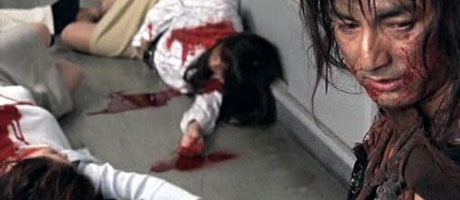 In other words, Izo catches up with Nakadai's character the moment he becomes the Angel of Death. So, what we have is a movie in which our hero is a supernatural creature that randomly jumps from one scene of violent death to another similarly grisly scene to yet another. And the sequence of events generated with no regard for time or space: in one moment, the killer obliterates a corpulent modern yakuza and his entourage; in the next, he's in Feudal Japan taking down a samurai. The film is a long, surprisingly thoughtful meditation on this conception of death as an unstoppable, merciless killing machine: death as the unjust, remorseless samurai who can never be bested. But the series of events unfolds without pause: he kills one target, turns around and is suddenly in a different building, in a different century, faced with no possible action but the inevitable violence.
In other words, Izo catches up with Nakadai's character the moment he becomes the Angel of Death. So, what we have is a movie in which our hero is a supernatural creature that randomly jumps from one scene of violent death to another similarly grisly scene to yet another. And the sequence of events generated with no regard for time or space: in one moment, the killer obliterates a corpulent modern yakuza and his entourage; in the next, he's in Feudal Japan taking down a samurai. The film is a long, surprisingly thoughtful meditation on this conception of death as an unstoppable, merciless killing machine: death as the unjust, remorseless samurai who can never be bested. But the series of events unfolds without pause: he kills one target, turns around and is suddenly in a different building, in a different century, faced with no possible action but the inevitable violence.
And that dulling, repetitive spatial/temporal disorientation is ultimately what makes Izo such a fascinating, unique film. Violence is always a tricky subject for any film to handle because it's almost invariably invigorating and exciting when done well: even shocking, upsetting violence still ends up being enjoyable on some level. Onscreen, violence is almost invariably reduced to (or certainly contaminated by) its pleasing, exhilarating elements. Izo emphatically decontextualizes the violence and, in doing so, slowly drains the power out of it. At a certain point in the film, the violence is neither fun nor interesting: it simply is. Once the veneer of exhilaration is diminished, Miike allows the audience to see the subject much clearer and contemplate it on deeper level than simply being excited or upset. The nature of the death that swarms around us all at every moment, the reality of our inevitable submission to an implacable force, is laid bare. The tactic is unique, for sure – what other film relies on a complete overload of violence to hammer an audience into a quiet, thoughtful rumination on the most furious of subjects?
The Cedar Bar
One of the most impressively embittered films I've ever seen, I would be hard pressed to describe Alfred Leslie's bellicose mélange as "good" or even "watchable." Leslie (best known for his oversight of the seminal beatnik mess Pull My Daisy) belongs to an artistic era (and mindset) that nonchalantly spewed forth many a cinematic endurance test and, consequently, The Cedar Bar actively courts your hatred. Thematically, stylistically, morally, it certainly isn't aiming to be "enjoyed" but, that's getting ahead of things.
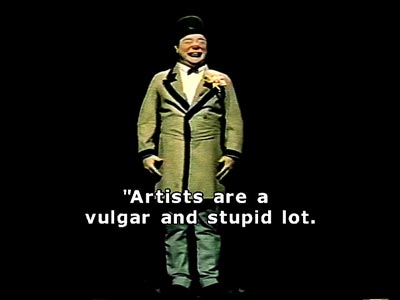
Like several of the films on this list, to even explain what The Cedar Bar is, is an incredibly convoluted process: in the 40's and 50's, Leslie was a regular at the titular NYC watering hole, the hangout of choice for the painters like William de Koonig, Joan Mitchell and Jackson Pollack who constituted a group of hotshots identified as the "Abstract Expressionists" by critic Clement Greenberg. During his time at the Cedar Bar, Leslie kept a notebook where he jotted down bits of conversations he had (and overheard) with the illustrious patrons. In 1952, he turned those notes into a play and then in 1966 the notebooks and all copies of the play were lost in a fire. In 1986, Leslie rewrote the play from memory, conjuring up all of the initially verbatim material over a hazy expanse of several decades. In 1997, the play was finally staged and then in 2002 Leslie took a left-turn with the project and shaped it into a film.
But the resulting object d'art is certainly no filmed play: a dense and bewildering exemplar of collage editing, The Cedar Bar starts with the half-remembered conversations of famous people and overlays a non-stop battery of stock footage and tangentially related images. Tinged with an experimental flavor exemplified by Bruce Connor, the film leans heavily on images from avant garde re-appropriation standbys like Hollywood classics, Holocaust documentaries, and hardcore pornography. The film switches almost randomly through the disparate images with only occasional moments of direct synchronicity. Leslie is also a big fan of cutting to reaction shots (of crowds, of audiences) and making it seem like the reactor in question is fawning over the words of the play. This type of relentlessly cut-up visual collage isn't particularly original on its own, but its combination with the play and its aggressively negative tone is memorable, to say the least.
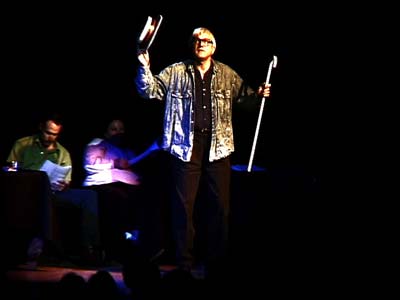 For starters, the play is intriguingly botched and, as a result, you spend great of time as a viewer wondered exactly what component, if any, of it is true. The half-remembered anecdotal musings of genuinely interesting iconic artists come out in a way that's always at least halfway mannered and phony-sounding, but intriguing for its possible elements of truth. The dialog is never less than awkward, stilted and completely full of shit but its possible veracities are tantalizing: did do Koonig really say something like this? Is that bit of dialog a composite expression of a true feeling of the real person behind the fake-y character? If you are at all interested in these artists, they hook really is fascinating and frustrating, fascinating because it is so absurdly frustrating. The lingering assertion of the material's truth engages you an endless guessing game of "actual statement, dramatic license, something along the lines of something that might have possibly been said or completely made up?" Leslie makes no effort to give you anything approximating the answers and, in this (and several other) ways, it's a film completely unconcerned with whether or not it's wasting your time.
For starters, the play is intriguingly botched and, as a result, you spend great of time as a viewer wondered exactly what component, if any, of it is true. The half-remembered anecdotal musings of genuinely interesting iconic artists come out in a way that's always at least halfway mannered and phony-sounding, but intriguing for its possible elements of truth. The dialog is never less than awkward, stilted and completely full of shit but its possible veracities are tantalizing: did do Koonig really say something like this? Is that bit of dialog a composite expression of a true feeling of the real person behind the fake-y character? If you are at all interested in these artists, they hook really is fascinating and frustrating, fascinating because it is so absurdly frustrating. The lingering assertion of the material's truth engages you an endless guessing game of "actual statement, dramatic license, something along the lines of something that might have possibly been said or completely made up?" Leslie makes no effort to give you anything approximating the answers and, in this (and several other) ways, it's a film completely unconcerned with whether or not it's wasting your time.
But let's get back to the extreme bitterness at the core of the film's soul: the theme driving Leslie to churn up these malformed memories is the arbitrariness with which fame and fortune are conferred. To the mind of the other painters as Leslie presents them, Greenberg is a complete fucking asshole who promoted Jackson Pollack (conspicuously absent from the proceedings of the film) for careerist reasons unrelated to any special qualities in Jackson's work. Greenberg's career was explicitly tied to the success of these painters, so he made conscious career moves in his writings and musing on the subject of their work: his fidelity was to success (personal success derived from the importance of the movement) and not to truth. And every movement needs a leader: Greenberg picked Pollack, whether or not that had any bearing on reality, whether or not his paintings were the best or most original or most well-liked by the general population. In Leslie's mind, Greenberg propped up his own reputation on the back of sordid half-truths and disingenuous hyperbole.
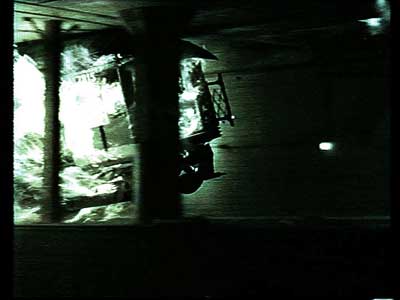 The film spins that hateful kernel into larger notions about the disgusting profession of criticism in general, giving ample time for meandering monologues spitting violently on the corpse of a deceased critic who did nothing but promote work that he thought was good. As with most foaming vitriolic, the essential issue is purity - specifically humans and groups that have an inability to live up to the rigorous, unbending standards put forth by other groups. In this case, the pure artists are failed by the impure critics. And Leslie has no qualms about shooting his anger wildly around in all directions at full force: in a film based in entirety around the vague associations between film clips and dialogs, Leslie has no problem suggesting that art critics are either miserable pornographers or worse than Eichmann.
The film spins that hateful kernel into larger notions about the disgusting profession of criticism in general, giving ample time for meandering monologues spitting violently on the corpse of a deceased critic who did nothing but promote work that he thought was good. As with most foaming vitriolic, the essential issue is purity - specifically humans and groups that have an inability to live up to the rigorous, unbending standards put forth by other groups. In this case, the pure artists are failed by the impure critics. And Leslie has no qualms about shooting his anger wildly around in all directions at full force: in a film based in entirety around the vague associations between film clips and dialogs, Leslie has no problem suggesting that art critics are either miserable pornographers or worse than Eichmann.
The film has an astounding commitment to pushing an audience's buttons. Bringing up the Holocaust to engage in petty, personal score-settling is basically as low as it gets, but the film's erratic editing (no shot or clip seems to last more than a dozen seconds) and strident tone really pummel an audience on a purely aesthetic level as well. That all said, his thesis at least fits together coherently with his convoluted methods: your reputation is always subject to somebody else's control and your artworks can always be appropriated for purposes you never intended. The film might be a disturbingly ornery mish-mash, but you won't walk out wondering what Leslie was getting at or why he chose such a contentious method of expression.
<<Previous Page 1 2 Next Page>>
home about contact us featured writings years in review film productions
All rights reserved The Pink Smoke © 2009